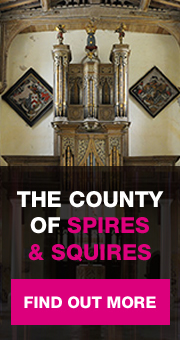This fine church, set in the tiny hamlet of Passenham, dates back to the 13th /14th century but was largely rebuilt in the early 17th – upper stages of the tower, the nave roof, and the whole of the chancel.
It is therefore a very interesting example of an indeterminate moment – is it a late Gothic survival or an early example of Gothic revival?
The rebuild was carried out by Sir Robert Banastre in 1626. His new chancel has a waggon roof painted with blue and golden stars (restored in 1960’s).
The choir stalls are two years later and have contemporary misericords in the form of a lion, unicorn, monster etc. Above them is decoration in a sort of Jonesian classism with painted shallow niches, fluted pilasters and a strapwork frieze. Between the pilasters are figures of prophets (Isaiah, Jeremiah, Ezekiel and Daniel), the Evangelist, and Nicademus and Joseph of Arimathea.
In all a very interesting example of early 17th century high church decoration inspired by the taste of Archbishop Laud. The painting is in good condition having been restored by Clive Rouse and Anne Ballatyne in the 1960’s (Rouse was an associate of Professor Tristram and did much to preserve Medieval wall paintings in the last century).
Banastre’s re built chancel was originally divided from the nave by a screen which now forms the base of the gallery at the north end of the church, having been moved there in 1772. It too is in a form of bastard classism with fluted ionic columns and strange fanciful frieze. Elsewhere in the church you will find box pews, a remodelled Jacobean pulpit, early 19th century Royal Arms and a marble font designed by Lawrence Bond in 1976.
The dedication to St Guthlac (674-715) is rare. He was a scion of a noble family from Lincolnshire. He is strongly associated with the Abbey of Crowlands near Peterborough where he lived as a hermit and where a shrine to him was erected in the 12th century. He has the unusual distinction of having a sainted sister, St. Pega.
Monuments
The principal monument in this church is in the chancel and appropriately to Sir Robert Banastre. Rather surprisingly when they came to erect it they placed it across one of the large figurative paintings: the picture of St Mark has largely given away to the sculpted bust of Sir Robert.
The monument, which consists of a half-length figure set into an oval niche, with wreaths and garlands in a classical architectural setting, is attributed to Thomas Cartwright the elder (c.1627-1702).
Little is known of this London based sculptor, indeed his only surviving written record is an account book in the Bodleian library covering the years 1656 -59. The work here, however, conforms to his documented tomb to Sir Roland St John with his wife and son (1656) in St Mary’s Woodford, Northants. Cartwright was a typical stonemason of his age who not only supplied monuments but tombstones, chimney pieces and sundials.
The monument post-dates Sir Robert Banastre glory days. He lived at Passenham from 1611 when he was already leasing land in the adjacent Royal Forest.
By 1624 he was able to purchase Passenham Manor, a reflection of his growing position at Court. He was comptoller to James l and became Clerk Victualler to Charles l as such responsible for food and drink at the Royal Court. He was also member of the Court of the Green Cloth and was responsible for the collection of Ship Money in the county. By 1640 he was wealthy enough to pay for the new chancel roof of Towcester church. Here at Passenham his coat of arms appears not on his tomb but unusually on the exterior wall of the church behind the tomb.
Given that he died in 1649, the year of Charles l execution, it is a moot point whether this monument was erected during the Protectorate or whether it dates from the early years of the Restoration. It may have been erected by his granddaughter who married into the Maynard family. It was her descendant, Charles, 2nd Viscount Maynard who altered the church in the 1770s removing the screen to the north end.
The only other monument of interest here is that to The Rev. Richard Forrester (d. 1769) which was probably supplied by one of the Cox family of Northampton. It’s rococo cartouches were one of their stock in trade pieces.
For more information on this church please see the excellent website www.mkheritage.co.uk/passenhamchurch







